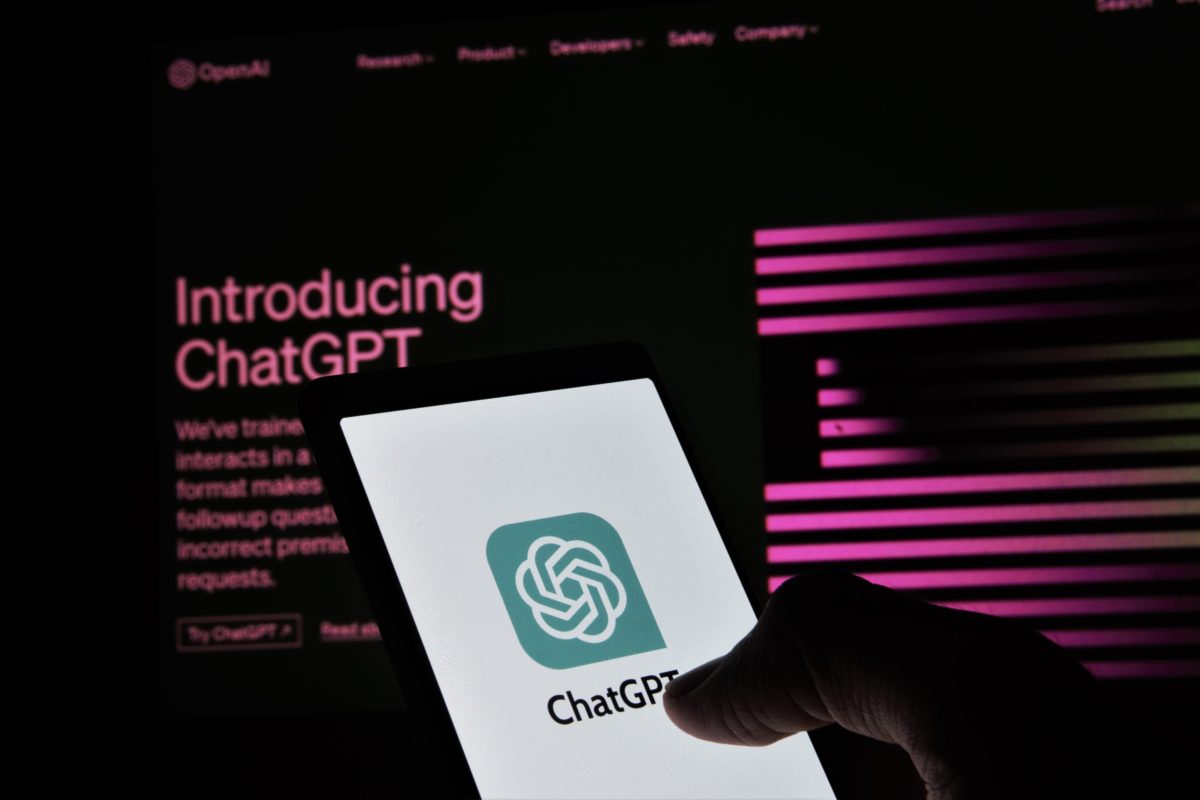ChatGPT: get to know the new generative artificial intelligence

ChatGPT is on everybody’s lips. In recent months, it has not stopped growing in popularity, and is a trending topic on social networks and the media. But what, exactly, is it? How does it work? And, of course, what are its main applications from a business perspective?
From the Fundación LAB, we provide an overview of all these questions in order to better understand this new model of artificial intelligence which is revolutionizing the world. The fact is the figures speak for themselves. Just five days before its launch, it had over a million users and, as we write these lines, ChatGPT sends us this message: ‘ChatGPT is at capacity right now’ .
What is ChatGPT?
ChatGPT is a chatbot based on a model of generative artificial intelligence, created by OpenAI, capable of “generating coherent and natural responses to questions on a variety of subjects, from history to technology and pop culture”. We put it in quotation marks because it is the description which ChatGPT provides of itself. It also adds: “ChatGPT has trained with millions of texts and conversations which enables it understand the context and respond accordingly. This makes it a valuable tool for a broad range of applications, from customer service to content creation”.
In fact, it is this coherence in dialogue that makes this artificial intelligence tool unprecedented, unlike any known so far. It is one of the most advanced AI systems known, as it goes beyond asking and answering questions; it is also capable of generating news, creating summaries, generating ideas for new projects or carrying out complex developments in programming languages.
How does ChatGPT work: learning system and doubts about its reliability
Like other artificial intelligences, ChatGPT requires training to operate based on text. It is asked questions; information is added, and it is corrected until it is capable of automatically carrying out a series of tasks. In the specific case of this AI, which is trained to hold conversations with anyone, its algorithms interpret what it is being asked and it is capable of giving a coherent response in the context of the question asked.
However, it is here where the main controversy lies: is this answer always right factually correct? On the one hand, its very normal manner of expressing itself is surprising, and makes it difficult to distinguish if the text was written by a person or artificial intelligence. Moreover, its easy operation, like a Google search, makes it a very useful tool and one that is close to the user, broadening the debate on its use.
In this respect, a student can use ChatGPT to write up 1,000 words on a specific subject. This artificial intelligence will generate content before you have time to make the first Google search for information but, is the content correct? Should we take everything ChatGPT gives in response as true? We must understand that the working of this AI, as the name itself indicates, is generative, that is, it is trained to generate content which is syntactically and morphologically correct, and which makes sense in the context of the conversation, but this generated content is not the result of a search and, consequently, does not necessarily have to be real.
Artificial intelligence under discussion: pros and cons
As with every great technological innovation (this one clearly is), the debate is on and ChatGPT already has its own “army” of defenders, though there are also many detractors. On the one hand are those who see this new system of artificial intelligence as a promising achievement for eventually obtaining an almost human AI. Others, however, highlight the proven inaccuracy of much of the data it offers, thus dampening its success.
Before going more deeply into the debate, we shall let it speak for itself. When asked “who are you?”, it gives the following cautious reply: “As a language model trained by OpenAI, I can process language and speak in a way similar to a human being. This means that I can understand questions and provide coherent answers using human language. However, unlike a human being, I have no self-awareness or the ability to think and reason autonomously. I am simply a computer program designed to imitate human language”.
On the side of the defenders, we have the expert in artificial intelligence and director of the ELLIS Foundation in Alicante, Nuria Oliver, who, in a recent interview for EFE Noticias, stated that the potential and advantages of ChatGPT “are much greater than its disadvantages”. This is why, for example, she does not agree with the decision by the city of New York or the Institute of Political Studies in Paris to ban the use of this artificial intelligence in their classrooms. For her, this AI implies “a deeper transformation” of education, beyond the ban of its use or not, which is why “it is important to consider which positive elements these great advances afford so that each student can best reach their potential, to promote writing and help boost creativity».
On the opposite side, Julio Gonzalo, vice-rector of research of the UNED, in an article in El País newspaper, explained that this online artificial intelligence is not capable of reasoning and does not have explicit knowledge. As he points out: “if ChatGPT were used now as a substitute for the university, it would be catastrophic, because ChatGPT lies with the same assurance as when it says things that are true”.
ChatGPT creates an irresistible illusion of rational thought. Yet, it is no more than a language model which *does not reason* or have *reliable knowledge* of the world. Below is an example of how it is carried away by its interlocutor and starts to rant. pic.twitter.com/jITyRA3sz7
— Julio Gonzalo (@JulioGonzalo1) December 3, 2022
ChatGPT applications for businesses
Now that this artificial intelligence has made the leap to the main-stream, Fundación LAB would like to explain how businesses can make proper use of a technology with such great potential. Below, we set out some of the first uses being considered at business level in order to improve the efficiency of certain processes and/or jobs.
- An improved artificial intelligence bot. With ChatGPT, the existing chat-bot services, computer programs that simulate human conversation through a chat, can be significantly improved thanks to their greater understanding of language. The new bots will improve with regard to the quality offered in customer service, as they are better able to understand and see to customers’ needs. Nowadays, bots’ answers are very limited, whereas ChatGPT understands the context of the conversation and can, therefore, improve its experience.
- Automating commercial cycles and sales. Will this artificial intelligence be capable of doing away with sales work? We still cannot answer this question, but it could help speed up administrative tasks so that sales people can focus on the more human side of the sales cycle and on responding to the individual needs in each case. This would be possible thanks to the fact that ChatGPT stands out in the automation of processes such as large-scale email drafting or creating sales documents.
- Quick and well-optimized translations. One of the advantages of this tool of online artificial intelligence is its ability to translate text that requires a minimum of editing. For now, ChatGPT can translate quite accurately several languages, including English, Spanish, French, German, Chinese or Japanese. What can still be achieved is greater agility in processes and reduction in costs, as only a subsequent review by an expert would be required.
- Creation of content for social networks. The immediacy in which we live means that businesses and brands need to be present on many social platforms, while creating constant content for them. This is where the help offered by ChatGPT comes in, from writing up a script for a YouTube video to drawing up a blog post for a website or variations for PPC (pay per click) ads, an online advertising model. It is therefore possible to do away with the operational part in order to focus on efforts in strategy to make it more powerful and ambitious.
- Semantic searches. This is probably the most horizontal use of all, one we lean on in all content generated in our company, in order to give context to the conversation we can have with ChatGPT, so that we can limit its responses to content previously generated within the organization. This would allow us to summarize memorandums, compare versions of contracts, extract relevant content in agreements, etc.
Fundación LAB Mediterráneo
Fundación LAB Mediterráneo is a project created by AVE with the mission of positioning the Region of Valencia as a national and European benchmark in entrepreneurship, innovation, technology and research.
To achieve this, it has set itself five objectives: to promote the creation and attraction of technology start-ups; to work to attract national and international technology companies to set up in the Region of Valencia and create a ‘tractor effect’; to promote support for companies in non-technological sectors to accelerate their digital transformation; to contribute to increasing private investment in R&D&I; and to help promote research.
The Foundation’s Board of Trustees is made up of the following entities Aceitunas Cazorla, Aquaservice/Plug and Play, AVE, Baleària, Banco Sabadell, Boluda Corporación Marítima, CaixaBank, Dacsa Group, Embutidos Martínez/KMZERO, GDES, Grupo AZA, Grupo Bertolín, Grupo Gimeno, Helados Estiu, Importaco, Lanzadera, Logifruit, Nunsys, Royo/ Invext, S2 Grupo, SPB/Cleanity TIBA/Romeu, Verne Technology Group y Zeus/Sesame.






